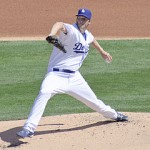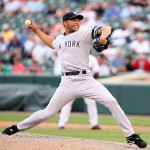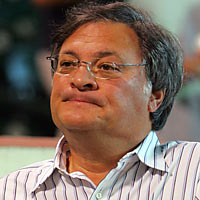This post is months in the making. In WordPress I looked up the first revision and it was dated May 4th. Its on at least its 50th revision. Its crazy. But its a fun piece to do, to kind of keep track of these awards throughout the season. But with yesterday’s release of the top-3 candidates for each BBWAA award, I thought it was finally time to publish. The top-3 announcement didn’t have too many surprises in it, but was eye opening for some of the also-rans in each category.
I like seeing how well I can predict these awards by reading the tea leaves of the various opinions that flow into my RSS feed (here’s 2012’s version of the same post with links to prior years). The goal is to go 8-for-8 predicting the major awards, with an even loftier goal of going 12-for-12 adding in the unofficial Sporting News awards. I succeeded in 8-for-8 in 2010 and 2011, but missed out last year by over-thinking the Manager of the Year award in the AL. This year is going to be tougher; the NL Rookie award and the AL Manager of the Year award are going to be coin-flips.
Here’s links for the MLB Players of the Month, to include Player, Pitcher and Rookies of the month, though frankly these monthly awards don’t amount to much. But they’re fun to go see who was hot and how they ended up (think Evan Gattis).
Here’s links to some mid-season award prediction columns from Tom Verducci, Matthew Pouliot and Jayson Stark. Here’s an 8/27/13 post from Keith Law, a 9/5/13 post from Cliff Corcoran, and a 9/25/13 prediction piece from USA Today’s Frank Nightengale that may be very telling about the Cabrera/Trout debate. Lastly a few end of season pieces from Stark, Passan, Pouliot NL and AL, Gammons, Keri, Olney, Heyman.
Lastly here’s a great Joe Posnanski piece complaining about the faults the typical BBWAA voter has in their methodology. He touches on some themes I mention below. Remember this is a prediction piece, not who I necessarily think should actually win.
Without further ado, here’s my predictions and thoughts on the awards (predicted winners in Blue).
- AL MVP: Miguel Cabrera (May’s AL player of the month) and was leading the league in nearly every offensive category through a big chunk of the season before injuries cost him a lot of September. There’s talk of another Cabrera-Mike Trout competition for the MVP in 2013, but I think the same results will hold as in 2012. It comes down to the simple question; how can you be the “MVP” of a last place team? That vastly over-simplifies the debate of course, but it is what it is. I continue to be impatient with holier-than-thou writers who ignore the BBWAA definition of the award and who think this MVP should just be a ranking of the seasonal WAR table. This award is not (yet) the “Best Player” award, and if it was then Trout would be the easy winner. Of the also-rans: Chris Davis tied the AL-record for pre-All Star break homers and finished with 53, but he’s likely #3 in this race. Rounding out my top 5 would be Josh Donaldson and Manny Machado. Names briefly under consideration here earlier in the season (and possible top 10 candidates) include Joe Mauer and Evan Longoria.
- AL Cy Young: Max Scherzer started the season 13-0 and finished 21-3. This will propel him to the award despite not being as quite as good overall as his top competition. Yu Darvish was on pace for nearly 300 strikeouts for a while before finishing with 277 and is likely finishing #2. Despite a losing record pitching for one of the worst teams in the league, Chris Sale pitched to a 140 ERA+ for the second season in a row and should be rewarded with a top-5 finish. Hisashi Iwakuma has fantastic numbers in the anonymity and depression of Seattle and will also get top-5 votes. Rounding out the top 5 could be one of many: Clay Buchholz was unhittable in April and weathered accusations of doctoring the baseball from the Toronto broadcast team (Jack Morris and Dirk Hayhurst specifically), but then got hurt and may fall out of the voting. Felix Hernandez put up his typical good numbers early despite a ton of kvetching about his velocity loss early in the season, but tailed off badly in August to drop him from the race. Anibal Sanchez‘s 17-strikeout game has him some buzz, and he led the league in both ERA and ERA+. Matt Moore became the first young lefty to start 8-0 since Babe Ruth and somewhat quietly finished 17-4 for the game-163 winning Rays. Lots of contenders here. Predicted finish: Scherzer, Darvish, Iwakuma, Sale, Sanchez.
- AL Rookie of the Year: Wil Myers may be the winner by default. Nobody else really stands out, and the biggest off-season narrative involved Myers and the big trade, meaning that nearly every baseball fan and writer knows of Myers’ pre-MLB exploits. Jose Iglesias put up good numbers in the Boston infield before being flipped to Detroit, and is a great candidate but most of his value resides in his defense, meaning old-school writers won’t vote for him over Myers. Past that, the candidates are slim. Justin Grimm‘s fill-in starts for Texas were more than adequate. Nick Tepesch is also holding his own in Texas’ rotation. Coner Gillaspie and Yan Gomes are in the mix. Texas’ Martin Perez put himself in the race with a solid year and got some last-minute exposure pitching in the game-163 tie-breaker. Leonys Martin is another Texas rookie that has quietly put up good numbers. Myers’ Tampa Bay teammate Chris Archer could get some votes. Predicted finish: Myers, Iglesias, Perez, Archer and Martin.
- AL Mgr: John Ferrell in Boston for going worst to first may be the best managerial job, but Terry Franconia in Cleveland deserves a ton of credit for what he’s done with significantly less resources in Cleveland and should win the award. Its hard to underestimate what Joe Girardi has done in New York with injuries and the media circus this year, but this award usually goes to a playoff bound team. I’ll go Franconia, Ferrell, Girardi.
- (Unofficial “award”): AL GM: Initially I was thinking Ben Cherington, Boston. He traded away all those bad contracts, brought in several guys under the radar, leading to a 30 game swing in its W/L record. Though, I agree with David Schoenfield; with Oakland’s 2nd straight AL West title it’s hard not to give this to Billy Beane.
- (Unofficial “award”): AL Comeback Player of the Year: Nate McLouth has come back from the absolute dead for Baltimore, though technically he was decent last year too. Josh Donaldson has come out of nowhere for Oakland, but really had nowhere to come “back” from. John Lackey and Scott Kazmir both rebounded excellently from injury plagued seasons. I think the winner has to be Kazmir by virtue of his slightly better record over Lackey. Editor’s update: this award was already given and I got it wrong: Mariano Rivera won for his great 2013 comeback; I completely forgot about him. We’ll cover the results versus my predictions in a future post.
- (Unofficial “award”): AL Fireman of the Year: Greg Holland, despite some sympathetic desire to give it to Mariano Rivera on his way out. Joe Nathan is also in the AL discussion. Jim Johnson is not; despite leading the league in saves for the 2nd year in a row he blew another 9 opportunities. I hope the voters see past that.
Now for the National League:
- NL MVP: Andrew McCutchen is the shoe-in to win, both as a sentimental favorite for the Pirates first winning/playoff season in a generation and as the best player on a playoff team. Clayton Kershaw‘s unbelievable season won’t net him a double, but I’m guessing he comes in 2nd in the MVP voting. Paul Goldschmidt has become a legitimate stud this year and likely finishes 3rd behind McCutchen and Kershaw. Rounding out the top 5 probably are two from Yadier Molina, Freddie Freeman and possibly Joey Votto as leaders from their respective playoff teams. Also-rans who looked great for short bursts this season include the following: Jayson Werth (who is having a career-year and making some people re-think his albatros contract), Carlos Gomez (who leads the NL in bWAR, won the Gold glove and led the NL in DRS for centerfielders but isn’t being mentioned at all for the NL MVP: isn’t that odd considering the overwhelming Mike Trout debate?? I’ve made this case in this space to little fanfare in the past; if you are pro-Trout and are not pro-Gomez, then you’re falling victim to the same “MVP Narrative” that you are already arguing against), and maybe even Matt Carpenter (St. Louis’ real offensive leader these days).
- NL Cy Young: Clayton Kershaw put together his typical dominant season and won’t lose out to any of his darling competitors. He may be the only unanimous vote of the major awards. Marlins rookie phenom Jose Fernandez probably finishes #2 behind Kershaw before squeaking out the RoY award. Matt Harvey was the All-Star game starter and looked like he could have unseated Kershaw, but a later season swoon and a torn UCL in late August ended his season and his chances early. He still likely finishes #3. Others who will get votes here and there: Jordan Zimmermann (who nearly got to 20 wins), Adam Wainwright (who is back to Ace-form after his surgery and is put together a great season), St. Louis teammate Shelby Miller, Patrick Corbin (Pitcher of the Month in May), Cliff Lee (who has been great for the mediocre Phillies), and perhaps even Zack Greinke (who finished 15-4; did you know he was 15-4?). Predicted finish: Kershaw, Fernandez, Harvey, Wainwright, Corbin.
- NL Rookie of the Year: Seems like its coming down to one of 5 candidates: Fernandez, Puig, Miller, Ryu and Teheran. I’d probably vote them in that order. Shelby Miller has stayed the course filling in St. Louis’ rotation and may also get Cy Young votes and seemed like the leading candidate by mid June. Evan Gattis, the great feel-good story from the Atlanta Braves, started out white-hot but settled down in to relative mediocracy. Tony Cingrani continued his amazing K/9 pace from the minors at the MLB level, filling in quite ably for Red’s ace Johnny Cueto but was demoted once Cueto returned and struggled with injuries down the stretch. Didi Gregorious, more famous for being the “other” guy in the Trevor Bauer trade, has performed well. Meanwhile don’t forget about Hyun-Jin Ryu, the South Korean sensation that has given Los Angeles a relatively fearsome frontline set of starters. Yasiel Puig took the league by storm and hit 4 homers his first week on the job. Jose Fernandez has made the jump from A-Ball to the Marlins rotation and has been excellent. Julio Teheran has finally figured it out after two call-ups in the last two years and has a full season of excellent work in Atlanta’s rotation. The question is; will narrative (Puig) win out over real performance (Fernandez)? Tough call.
- NL Mgr: Clint Hurdle, Pittsburgh. No real competition here. Some may say Don Mattingly for going from near firing in May to a 90 win season … but can you really be manager of the year with a 250M payroll?
- (Unofficial award) NL GM: Neal Huntington, Pittsburgh. It really has to be Huntington for pulling off the low-profile moves that have paid off with Pittsburgh’s first winning season in 20 years. Ned Colletti‘s moves may have resulted in the best team in the league, but he has the benefit of a ridiculously large checkbook and I hope he doesn’t win as a result.
- (Unofficial “award”): NL Comeback Player of the Year: I’d love to give this to Evan Gattis for his back story but that’s not the point of this award. I’m thinking Carlos Gomez with Milwaukee for his massive out-of-nowhere season. But honestly the award has to go to Francisco Liriano. Editor’s update: this award was already given and I got it right: Liriano indeed won.
- (Unofficial “award”): NL Fireman of the Year: Craig Kimbrel, who looks to finish the year with a sub 1.00 ERA for the second year running. Edward Mujica and Aroldis Chapman in the discussion but not really close.


